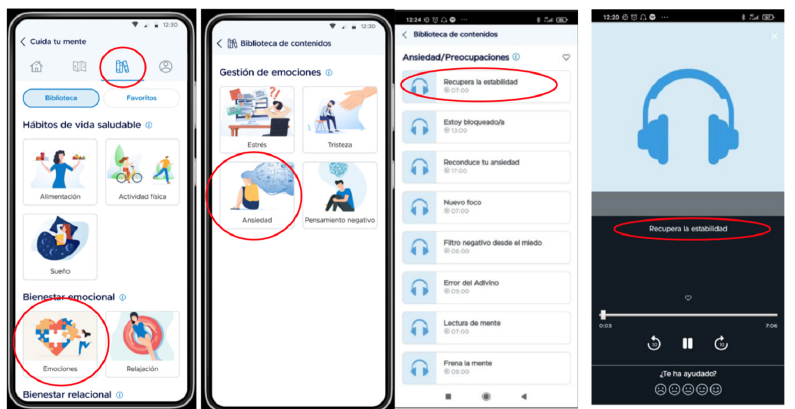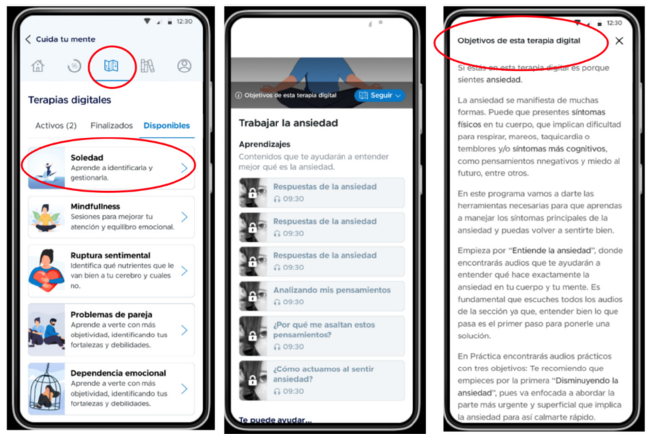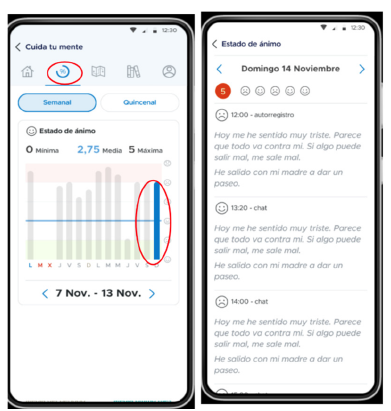- Submissions

Full Text
Trends in Telemedicine & E-health
Impact of a Digitally Enabled Therapy to Treat Depression and Anxiety in Adults
César Morcillo Serra1*, Soraya Bajat Pacios2, Daniel Tizon Galisteo3, Irene Sainz Barreiros4, Jesús Jerónimo Jiménez4, and José Francisco Tomás Martínez5
1Medical Direction, Sanitas Digital Hospital, Spain
2Mental Health Service, La Zarzuela and La Moraleja University Hospital, Sanitas, Spain
3Artificial Intelligence Department, BUPA ELA, Spain
4New Digital Products and Services, Transformation Department, BUPA ELA, Spain
5Medical Direction, BUPA ELA, Spain
*Corresponding author:César Morcillo Serra, Medical Direction, Sanitas Digital Hospital. Ribera del Loira, 52. 28042 Madrid, Spain
Submission: June 28, 2023; Published: July 11, 2023

ISSN: 2689-2707 Volume 4 Issue 3
Abstract
Background:Digital solutions are useful for chronic diseases like mental health disorders, where
traditional healthcare cannot fulfill the unmet needs, and behavioral change is required for comprehensive
disease management.
Study Design:we describe a psychology digital service that can help patients tackle the areas of
prevention, management, and treatment of their mental and emotional health. All through a mobile app,
it offers an integrated approach, combining digital content with the option for care treatment. Patients
can complete an online psychological assessment through a bot, access digital content, and follow up with
their psychologist if needed. We present the protocol, the methodology used by the application and the
impact of its use in the first months after its launch.
Results:35,823 clients have voluntarily signed up for the program within a span of 9 months. After
completing the bot’s mental health questionnaires, the Artificial Intelligence (AI) algorithm determined
that 8.9% of users did not have any mental health problems, while the remaining 91.1% exhibited
symptoms. Out of these individuals, 3,094 have received digital consultation treatment from the
psychology team, which enabled personalized digital treatment for them.
Conclusion:the described psychology digital service has facilitated rapid psychological self-assessment,
early detection of mental health problems, and, if needed, immediate assistance through audiovisual
material, conversations with a chatbot, and online consultations with psychologists.
Keywords:Digital Therapy; Digital health; Mental health; Telemedicine; Bot; Artificial intelligence
Abbreviations:AI: Artificial Intelligence; NICE: National Institute for Health and Care Excellence
Introduction
Digital solutions are useful for chronic diseases like mental health disorders, where
traditional healthcare cannot fulfill the unmet needs, and behavioral change is required for
comprehensive disease management [1]. Three types of digital health solutions are defined,
depending on their use [2]:
A. Prevention: with lifestyle management and interventions to delay the development
of these chronic diseases
B. Management: helping patient populations effectively manage their diseases by
capturing symptoms and improving adherence to treatments, such as web portals connected
to wearables. Real-time recommendations and educational coaching messages could be
provided based on activity and mood values captured in patients’ apps and sensors
C. Treatment: working independently or in conjunction
with pharmacological treatments, there are digital cognitive
behavioral therapy solutions that target mental health and
behavioral disorders.
At a time when mental and emotional health deserve special attention, we have created “Cuida tu mente.” This is a psychology digital service that, with the most innovative technology and a professional team, can help patients tackle the areas of prevention, management, and treatment of their mental and emotional health. All through a mobile app, it offers an integrated approach, combining digital content with the option for care treatment. Patients can complete an online psychological assessment through a bot, access digital content to work on their mood in a personalized manner, and follow up with their psychologist if needed.
In this paper, we present in detail the methodology used by the application and the impact of its use in the first months after its launch.
Materials and Methods
The psychology digital service was offered to Sanitas insurance clients in Spain who wanted to prevent and promote their emotional well-being, always with the option of having a video consultation with a psychologist, and also to clients who required psychological treatment by a psychologist, who could have their consultations and digital follow-up enhanced with content adapted to their diagnosis.
The psychology digital service starts with an interaction with a chatbot to conduct a psychological assessment. This is a structured interview to assess the current emotional state of a person and detect the need for assessment/intervention by one or more specialists. All questions and possible answers of the interview have been defined by our psychologists. The interview assesses the objectivity of clinical and subclinical symptoms, based on the diagnostic criteria of the main mental disorders of the Spanish population, as well as evaluating the subjective state of emotional well-being. Depending on the type of disorder and the symptomatic intensity, the patient is referred to the most appropriate specialist. The purpose of the assessment interview is not diagnostic; its purpose is to assess the emotional state, and when a reason for consultation is detected, it refers the patient to the most appropriate specialist based on the answers given.
Based on the outcome of the mental health assessment, the patient can access self-consumable digital content to work on specific goals, accompanied by a psychologist if needed, or the system will recommend making a video or in-person consultation appointment with a professional who will guide the patient through the process. The digital content library is divided into wellbeing content and digital therapies. The well-being content has three areas: 1) emotional management (stress, sadness, anxiety, and negative thoughts) and relaxation (mindfulness and relaxation techniques), 2) healthy living habits (diet, exercise, and sleep), and 3) relational well-being (social and couple relationships) (Figure 1). The digital therapies consist of a series of 13 short audiovisual bulletins designed to help clients detect, understand, and manage emotions in their daily lives. Clients can consume the bulletins one by one in the order set by the mobile app (Figure 2). Customers can also personalize their content, save their favorites, and record their emotions to have a personalized experience.
Figure 1:Example of self-guided well-being digital content.

Figure 2:Example of self-guided digital therapy.

With all the information about the client, including their behavior within the app (what they consume, what they like, and what interests them), there is a recommender AI algorithm that can recommend daily audiovisual content that clients have not yet consumed and that it believes can help them. Once the client attends the psychology consultation, the psychologist will determine the diagnosis. If it is deemed beneficial for the client to undergo digital follow-up, a follow-up profile will be assigned based on the client’s mental status directly from the electronic health record.
Follow-up profiles for patients are conversations with the bot based on self-registration techniques, aimed at supporting the patient during the periods between consultations, acting as a psychoeducational tool, promoting introspection and treatment adherence, as well as recording the evolution of symptoms and/ or the level of emotional distress. All follow-up profiles have the same structure of daily self-registration and follow-up questions (Figure 3). However, each profile is adapted to the symptomatic group it refers to, both in the coding of self-registration scores and in the symptoms, questions, and bot responses (Example: presence/absence of panic attacks and duration of the crisis only in high anxiety/risk of panic attack or panic attack profile). To assist the patient in completing the daily self-registration and follow-up questions, the patient will receive push notifications on their phone twice a day in case there are pending tasks.
Figure 3:Example of follow-up screens.

In addition to the bot, the patient will have access to a series of specific digital contents deemed beneficial for their treatment. These profiles are designed based on the main symptomatic groups that are the reason for consultation: anxious symptomatology, depressive symptomatology, mixed anxiety-depressive symptomatology, emotional distress due to cognitive, emotional, and/or maladaptive behavioral responses secondary to perceived stress, or emotional distress due to cognitive, emotional, and/ or maladaptive behavioral responses secondary to personality structure.
The psychologist may modify the follow-up profile based on the predominant symptoms at each moment or the focus of psychotherapeutic intervention. If the client has been recommended to schedule an appointment in any of the following specialties: psychiatry, gynecology, urology, general medicine, or neurology, the client’s symptoms often require prior medical evaluation for differential diagnosis or consideration of multidisciplinary intervention. Hence, the referral to other specialists is based on the client’s responses. The client will have direct access to the appointment platform within the mobile app with the preselected specialty for scheduling the appointment process.
Result and Discussion
Since the launch of this new digital solution for mental health management in October 2023, 35,823 clients have voluntarily signed up for the program within a span of 9 months. After completing the bot’s mental health questionnaires, the AI algorithm determined that 8.9% of users did not have any mental health problems, while the remaining 91.1% exhibited symptoms. Out of these individuals, 3,094 have received digital consultation treatment from the psychology team, which enabled personalized digital treatment for them. In this work, we have demonstrated how the methodology applied in the development of this innovative digital solution has enabled rapid psychological self-assessment, early detection of mental health problems, and immediate assistance through audiovisual material, chatbot conversations, and online consultations with psychologists.
The described psychology digital service has helped patients
take care of their mental and emotional health based on four pillars:
A. Diagnostic approach: to assist them in better
understanding themselves, learning about their concerns, and
becoming aware of their environment.
B. Digital therapies: providing personalized content
(videos, audios, and reading material) to enhance their mental and
emotional well-being.
C. Accompaniment: allowing them to record their emotions,
physical activity, and sleep patterns to support prevention and
treatment.
D. Professional support: granting access to 240
psychologists through video or face-to-face consultations whenever
needed.
We align with the NICE recommendation that digitally enabled therapies should be delivered with practitioner or therapist support, including regular monitoring and the management of patient safety and progress [3].
Digital medicine products, such as digital diagnostics and, in particular, digital therapeutics, have demonstrated their significant utility as evidence-based software-based solutions for the prevention, management, and treatment of mental health conditions. Among the most beneficial technologies are telemedicine solutions, including video consultations and telemonitoring with mobile apps connected to sensors and wearables. Other valuable solutions utilize AI algorithms to facilitate early diagnosis, employing chatbots or digital biomarkers like voice recognition. Additionally, digital cognitive behavioral therapy and real-time interventions are enabled by these technologies [4]. Simultaneously, digital solutions that incorporate gaming or virtual reality-based experiences, as an extension of digital behavioral interventions, have shown positive results [5].
Therapies such as cognitive behavioural therapy lend themselves to digital implementation. Indeed, the National Institute for Health and Care Excellence (NICE) has recommended eight digitally enabled therapies to treat depression and anxiety in adults [6]. Space from Depression, for example, has been evaluated in practice and has the potential to free up staff time, potentially improving waiting times and access to care. Deprexis claims to be the world’s most researched digital therapy program for depression, as supported by evidence from 11 randomized controlled trials [7].
Digital therapeutics bring benefits to patients, providers and health systems, policymakers and payors [8].
For patients, digital therapeutics offer empowerment in various ways: monitoring and self-managing their health, accessing clinically effective and safe therapies, improving adherence to treatment, overcoming limited access to therapy, receiving updates on outcomes through regular monitoring, enhancing patient experience, receiving care in a more convenient setting (such as at home), reducing the number of face-to-face interventions, increasing access for underserved populations, and enabling more predictive, preventative, personalized, and participatory care.
Providers and health systems also benefit from digital therapeutics. They gain increased access to new treatment options for patients with unmet needs, improved patient adherence and outcomes while freeing up health system capacity through the prescription of clinically proven self-management therapies, enable intelligent data-driven care management and clinical decision support, serve a larger number of patients more effectively and at a lower cost, and integrate data with health care delivery systems, including patient engagement and response to therapy.
Similarly, policymakers and payors find value in digital therapeutics. These solutions improve clinical and health economic outcomes, particularly for patient populations with chronic disorders and high unmet needs. They decrease overall healthcare costs of medical interventions and enable new models of care, such as value-based care and population health management.
However, it is important to acknowledge the limitations of these digital solutions. The quality of virtual care depends on specific patient factors, including circumstances that may hinder proper care via telemedicine or other digital solutions, such as hearing or vision difficulties, cognitive impairment, severe cases of mental ill health, learning or language difficulties, or a lack of digital skills or access to technology [9]. The high number of clients with mental health problems detected in this study is surprising. However, there may also be a limitation of bias in the sample selection, as the individuals included voluntarily sought a psychological assessment and likely had symptoms motivating them to do so. It is important to note that our solution has been developed and used exclusively for individuals of legal age. We have not analyzed its use in children, despite the existence of extensive literature on similar solutions for minors [10].
Conclusion
In conclusion, the described psychology digital service has facilitated rapid psychological self-assessment, early detection of mental health problems, and, if needed, immediate assistance through audiovisual material, conversations with chatbots, and online consultations with psychologists. As it has already been published [11], digital therapies provide evidence for the efficacy for the treatment of depression and anxiety, and an alternative approach for individuals to seek help in a manner that may better align with their personal needs, offering flexibility in terms of treatment timing and location.
References
- Balcombe L, Leo DD (2021) Digital mental health challenges and the horizon ahead for solutions. JMIR Ment Health 8(3): 26811.
- (2023) Digital therapeutics alliance understanding Dtx: A new category of medicine.
- (2023) National Institute for Health and Care Excellence (NICE). Digitally enabled therapies for adults with depression: early value assessment,
- Serra CM, Romero JLG (2020) New digital healthcare technologies. Med Clin (Barc) 154(7): 257-259.
- Lord SE, Campbell ANC, Brunette MF, Cubillos L, Bartels SM, et al. (2021) Workshop on implementation science and digital therapeutics for behavioral health. JMIR Ment Health 8(1): 17662.
- (2023) National Institute for Health and Care Excellence (NICE). Eight digitally enabled therapies to treat depression and anxiety in adults conditionally recommended by NICE,
- Deprexis-mild to severe symptoms of depression.
- Khirasaria R, Singh V, Batta A (2020) Exploring digital therapeutics: The next paradigm of modern health-care industry. Perspect Clin Res 11(2): 54-58.
- Williams MG, Stott R, Bromwich N, Oblak SK, Espie CA, et al. (2020) Determinants of and barriers to adoption of digital therapeutics for mental health at scale in the NHS. BMJ Innovations 6(3): 92-98.
- Williams JE, Pykett J (2022) Mental health monitoring apps for depression and anxiety in children and young people: A scoping review and critical ecological analysis. Soc Sci Med 297: 114802.
- Moshe I, Terhorst Y, Philippi P, Domhardt M, Cuijpers P, et al. (2021) Digital interventions for the treatment of depression: A meta-analytic review. Psychol Bull 147(8): 749-786.
© 2023 César Morcillo Serra. This is an open access article distributed under the terms of the Creative Commons Attribution License , which permits unrestricted use, distribution, and build upon your work non-commercially.
 a Creative Commons Attribution 4.0 International License. Based on a work at www.crimsonpublishers.com.
Best viewed in
a Creative Commons Attribution 4.0 International License. Based on a work at www.crimsonpublishers.com.
Best viewed in 







.jpg)






























 Editorial Board Registrations
Editorial Board Registrations Submit your Article
Submit your Article Refer a Friend
Refer a Friend Advertise With Us
Advertise With Us
.jpg)






.jpg)














.bmp)
.jpg)
.png)
.jpg)










.jpg)






.png)

.png)



.png)






